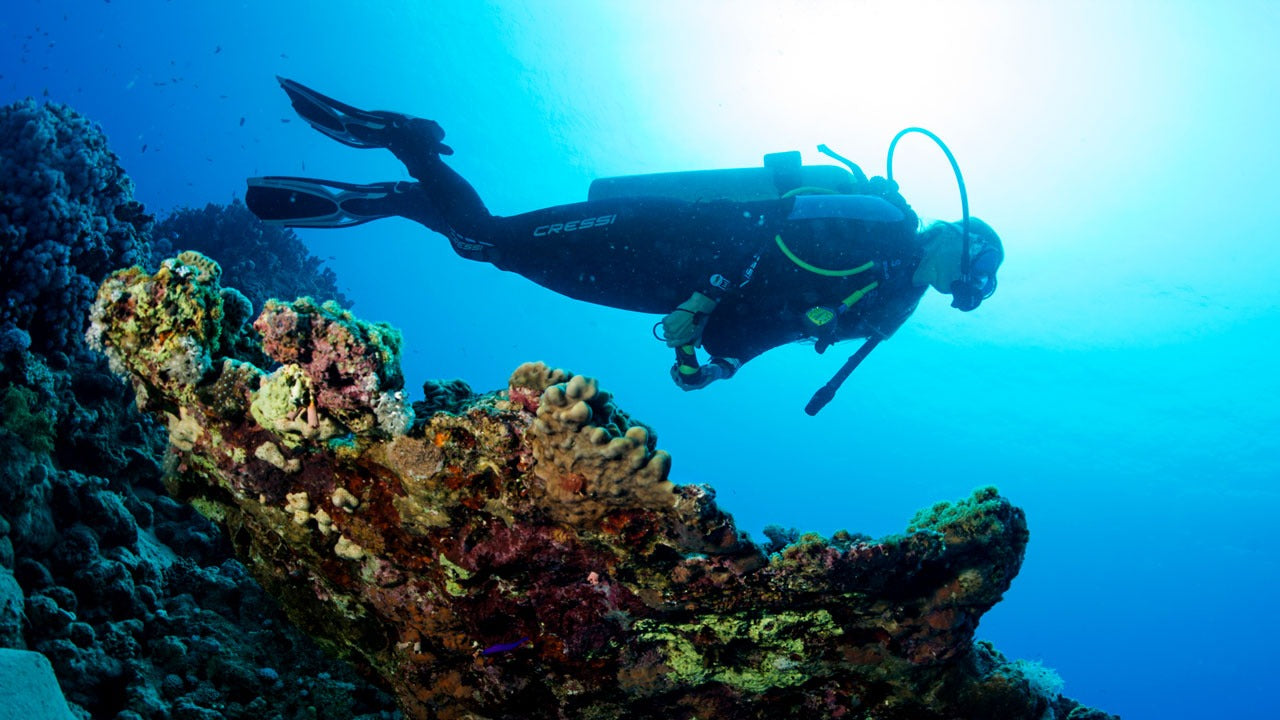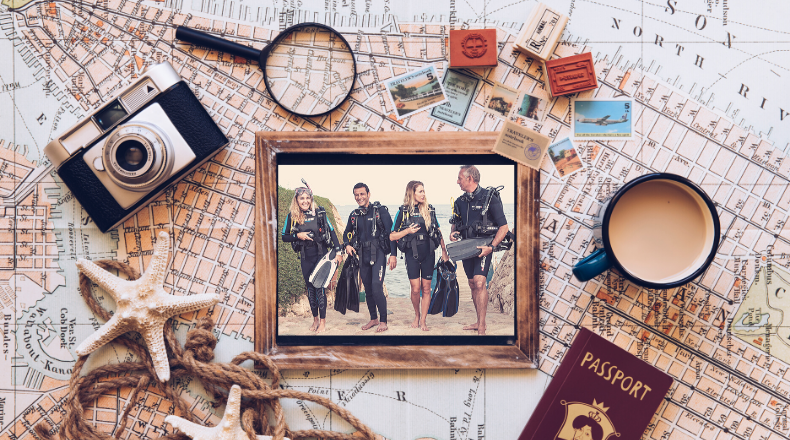Basic Principles of Light Underwater

Underwater photography can be exceptionally challenging due to the specific effects of water on light. It is easy to shoot on land, as the sunlight is usually sufficient. However, it is not the case underwater, since the ambient light alone isn’t enough to enrich your images with colors and liveliness. The absorption of light caused by water is much stronger than that produced by air. Therefore, understanding the peculiarities of this process and knowing possible workarounds are crucial for making good pictures underwater.
Light Loss
The density of water is approximately 800 times higher than that of air. Consequently, the light is absorbed very fast resulting in dim and monotonous colors as well as decreased contrast and sharpness of your pictures. If you are new to underwater photography, you may get frustrated in the beginning, however, knowing exactly how water as a medium changes the quality of light will definitely help you to improve your pictures.
It’s all about the distance. Different wavelengths of light disappear at different depths underwater. In fact, the colors dissipate in the same order as they are presented in the color spectrum: red, orange, yellow, green, blue, indigo, and violet. Here is a small overview showing at what depth what color disappears first:
| Color | Depth |
|---|---|
| Red | 15 - 20 ft |
| Orange | 25 - 30 ft |
| Yellow | 35 - 60 ft |
| Green | 70 - 90 ft |
| Blue | 95 - 180 ft |
Keep in mind that horizontal distance from the object of your shot also adds up to the total distance. Thus, if you are 20 ft underwater and the object is 15 ft away, the actual distance that the light will travel is 35 ft, which means that all the red and orange will fade away. Even if you are using a strobe, the distance between you and the object will double up, as the light has to travel to the object and then back to your lens, resulting in a significant loss of color. Therefore, always try to get closer to the object, to reduce the light path, and to preserve as much color as possible (without disturbing marine life of course). The best practice to keep the colors in place is to hold both the camera and the light source near the object. To achieve the best results, very wide-angle lenses are commonly used for these purposes. In combination with properly adapted angular coverage of the light source, you can convey a better vision of the underwater world through your images.
Refraction
When the light travels from one medium to another (from air to water), the light wave changes its speed and direction. This process is called refraction, and it is another property of water that may have a direct impact on your images. Although this effect is not as strong as the light absorption, it is still worth mentioning here. As a result of refraction, the objects can appear up to 25% closer and around 33% bigger than they actually are. This phenomenon occurs only if you are viewing the object through a flat surface, such as your mask, compact camera underwater housing, or a macro port. If you are using a dome port, you’ll be able to avoid this effect. As a matter of fact, most manufacturers of underwater housing camera ports include parameters of refraction into their designs. So as long as your port isn’t flat, you do not have to worry about it.
Color Temperature
While the term color temperature originates from physics and, roughly speaking, means the temperature of a light source that radiates color, in photography, it is used to measure the ratio between blue and red light within an image. Intuitively, we identify more blueish colors as cold and more reddish ones as warm. However, what we call a warm color has a lower color temperature (400 - 5000 Degrees Kelvin), whereas supposedly cold colors have in fact higher color temperature (more than 5000 K). In the following table, you can see some common lighting settings with respective color temperatures:
| Temperature | Light Source | |
|---|---|---|
| ---------------- | 1,000 K | Candles; oil lamps |
| 2,000 K | Very early sunrise; low effect tungsten lamps | |
| Warm tones | 2,500 K | Household light bulbs |
| ---------------- | 3,000 K | Studio lights, photofloods |
| 4,000 K | Clear flashbulbs | |
| Neutral tones | 4,300 K | Subtronic, Seacam Strobes |
| 4,800 K | Ikelite strobes | |
| ---------------- | 5,000 K | Typical daylight; electronic flash |
| 5,400 K | SEA & SEA Strobes | |
| 5,500 K | The sun at noon, INON strobes | |
| 6,000 K | Bright sunshine with clear sky | |
| 7,000 K | Slightly overcast sky | |
| Cool tones | 8,000 K | Hazy sky |
| 9,000 K | Open shade on a clear day | |
| 10,000 K | Heavily overcast sky | |
| 11,000 K | Sunless blue skies | |
| 12,000+ K | Open shade on a clear day |
You may wonder how this can be applied to underwater photography. As a new photographer, you might have already noticed that when you make a shot it has blue tinges, whereas to your eyes the colors of the scene are perfectly balanced. If you want to fix this issue once and for all, you need to understand white balance. To put it simply, it is a setting that adjusts the camera to specific lighting conditions aiming to keep white objects as white as they are in the real scene, hence preserving the naturalness of colors. As we see from the table above, different lighting conditions produce different effects on the picture. To a human eye, white appears white regardless of the lighting, as our brain compensates and adjusts the perception. If you look at a white piece of paper, it will always be white, both at home and in the street. Digital cameras, however, can get confused and paint the same white paper in different shades, since the lighting is different. Photographers call it a difference in light temperature. Thus, white plays a fundamental role in reflecting the colors properly.
If your camera is equipped with Underwater Scene Mode, the white balance for underwater light conditions are adjusted automatically; otherwise, you will have to take some additional steps:
- The Daylight Mode is usually suitable for shooting in shallow water or near the water surface up to 5-10 meters deep, as well as for macro photography with flash.
- If you work with external strobes or video lights, Automatic white balance mode should work fine for you, since the light emitted by strobes is very similar to normal daylight.
- For deep water photography, or if you take flash macro shots with a noticeable blue tinge, use the Cloudy mode to restore color balance and get rid of the color shift towards the blue part of the spectrum.
- Use external filters. The red filter removes the over-saturation of green and blue. The purple filter removes the over-saturated green. The pink filter corrects cyan saturation.
- Use custom white balance mode and import the settings manually. For this, choose custom white balance in your camera settings, point the camera at something white making sure that the object fills the whole frame, and finish the setup by pressing the shutter, menu, or OK button (refer to your camera’s manual for the exact steps). Keep in mind that at each new depth, the lighting will change, so you will need to readjust your camera settings accordingly. It is generally recommended to reset your custom white balance every 10 -15 feet.
- It is also possible to fix the white balance issue in post-processing to some extent. But this method does not guarantee good quality. For instance, if you make a shot at a depth of 25 feet, there will be no red at all in your image. As a result, adding it in the editing tool afterward may look very unnatural.
Reflected Light and the Time of Day
The amount of light coming from the sun and sky and its brightness depends on the season, time of the day, location, and sky condition. Furthermore, the condition of the surface affects the amount of light that penetrates the water. Thus, calm water lets more light in, whilst stormy water reflects more light. Also, the position of the sun determines how much light is reflected: direct sunlight from above is reflected less than the light from the horizon. Therefore, it is recommended to shoot between 10 AM and 2 PM when the sun is highest in the sky and the least light is reflected by the surface. During this time, the lighting conditions underwater will be the brightest. If you would like to add a softer touch to your images, take advantage of early hours, or a golden hour before the sunset, where light has the mildest quality.
Conclusion
The properties of light underwater impose many challenges for marine photographers. The biggest issue is color loss, which happens due to the absorption of light by water. To fix the colors and restore lost contrast, photographers need to come up with ways of compensation, which can be achieved with filters and external artificial lighting such as underwater strobes. The colored filters can correct color loss only to some extent and at shallow depths. To retain vivid colors at greater depths, it is better to use strobes, as they emanate daylight-balanced light that brings contrast back into place, preserves details and highlights textures. Furthermore, strobes are indispensable where it is necessary to fill up dark places with light. Therefore, if you want to substantially improve your underwater photography, strobes are the most effective solution.




